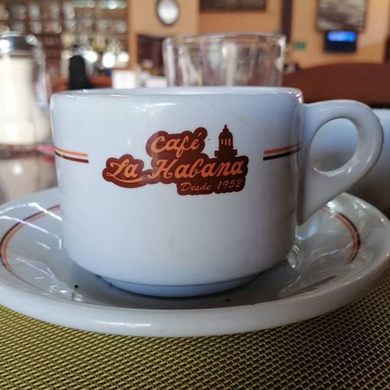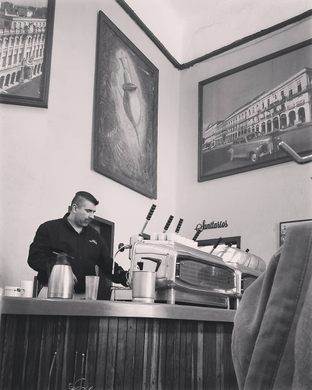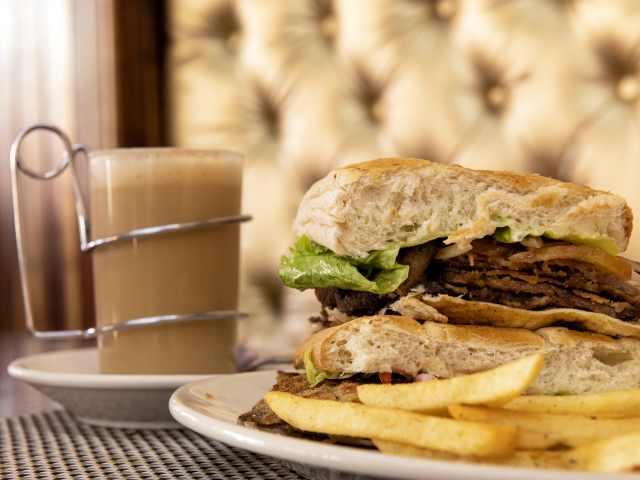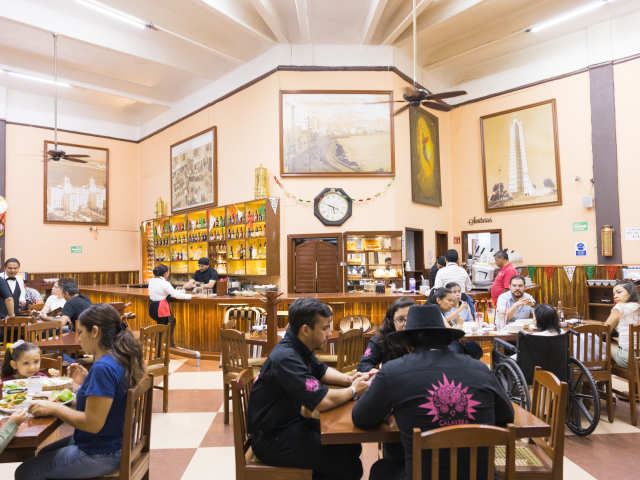Café La Habana
Historic cafe: Castro & Che's haunt, great coffee & food
Historic cafe: Castro & Che's haunt, great coffee & food




































"This old-school spot, with high ceilings and fans that are always spinning no matter what temperature it is outside, has been around since 1952, and once served regulars like Fidel Castro and Gabriel Garcia Marquez. (Today, there’s a Soho House next door.) Legend has it that Castro’s order was “a torta with everything,” which then became known as the torta cubana: a roll stuffed with roasted pork, beef milanesa, eggs, chorizo, ham, and american cheese, which you can get here for just seven of today’s dollars. Order one of those and end your meal with something sweet, like their signature two shots of espresso with condensed milk." - guillaume guevara


"This old-school spot, with high ceilings and fans that are always spinning no matter what temperature it is outside, has been around since 1952, and once served regulars like Fidel Castro and Gabriel Garcia Marquez. (Today, there’s a Soho House next door.) Legend has it that Castro’s order was “a torta with everything,” which then became known as the torta cubana: a roll stuffed with roasted pork, beef milanesa, eggs, chorizo, ham, and american cheese, which you can get here for just seven of today’s dollars. Order one of those and end your meal with something sweet, like their signature two shots of espresso with condensed milk." - Guillaume Guevara


"Every revolutionary needs a signature drink. For Karl Marx, it was wine; for Thomas Jefferson, well, it was also wine. But as they sat in Mexico City plotting the Cuban Revolution, Fidel Castro and Ernesto “Che” Guevara preferred coffee. Legend has it, the pair met at Café La Habana on a weekly basis to sip cups of joe and plan their strategy for political and social reform. But to think that this cafe’s claim to fame begins and ends with Castro and Guevara would be misleading, as it wasn’t just the haunt of political revolutionaries but also revolutionary writers. Some of the regulars who changed Latin American literature as we know it were known to sit for hours in the cafe, chain-smoking and discussing their ideas. Since La Habana’s opening in 1952, it’s played host to Gabriel García Márquez, Roberto Bolaño, and Octavio Paz. Crowds of journalists from nearby newspapers have also kept the conversation and coffee flowing. The cafe’s fame among cultural greats has, in fact, become something of a trope: Today, Mexican politicians frequent the spot when they want some positive publicity. In the cafe’s old-school interior, the scent of coffee and huevos al gusto mixes with the sound of conversation and the clank and sputter of espresso machines. It’s easy to imagine how the place looked, smelled, and felt in the 1950s (a little smokier, perhaps, but more or less the same). The walls remind patrons of this storied history, showing off black and white photographs of Mexico City and Havana, Cuba. The menu offers unfussy classics, including chilaquiles, molletes, and coffee roasted and ground on site, brought by waiters so seasoned they may well have served Che. While the chilaquiles and club sandwiches are pretty good, the food overall is average. But patrons should not come to the establishment to savor the food, but to sit, contemplate, have a strong café americano, and soak up its nearly 70 years of history." - ATLAS_OBSCURA


"Every revolutionary needs a signature drink. For Karl Marx, it was wine; for Thomas Jefferson, well, it was also wine. But as they sat in Mexico City plotting the Cuban Revolution, Fidel Castro and Ernesto “Che” Guevara preferred coffee. Legend has it, the pair met at Café La Habana on a weekly basis to sip cups of joe and plan their strategy for political and social reform. But to think that this cafe’s claim to fame begins and ends with Castro and Guevara would be misleading, as it wasn’t just the haunt of political revolutionaries but also revolutionary writers. Some of the regulars who changed Latin American literature as we know it were known to sit for hours in the cafe, chain-smoking and discussing their ideas. Since La Habana’s opening in 1952, it’s played host to Gabriel García Márquez, Roberto Bolaño, and Octavio Paz. Crowds of journalists from nearby newspapers have also kept the conversation and coffee flowing. The cafe’s fame among cultural greats has, in fact, become something of a trope: Today, Mexican politicians frequent the spot when they want some positive publicity. In the cafe’s old-school interior, the scent of coffee and huevos al gusto mixes with the sound of conversation and the clank and sputter of espresso machines. It’s easy to imagine how the place looked, smelled, and felt in the 1950s (a little smokier, perhaps, but more or less the same). The walls remind patrons of this storied history, showing off black and white photographs of Mexico City and Havana, Cuba. The menu offers unfussy classics, including chilaquiles, molletes, and coffee roasted and ground on site, brought by waiters so seasoned they may well have served Che. While the chilaquiles and club sandwiches are pretty good, the food overall is average. But patrons should not come to the establishment to savor the food, but to sit, contemplate, have a strong café americano, and soak up its nearly 70 years of history." - ATLAS_OBSCURA


"Every revolutionary needs a signature drink. For Karl Marx, it was wine; for Thomas Jefferson, well, it was also wine. But as they sat in Mexico City plotting the Cuban Revolution, Fidel Castro and Ernesto “Che” Guevara preferred coffee. Legend has it, the pair met at Café La Habana on a weekly basis to sip cups of joe and plan their strategy for political and social reform. But to think that this cafe’s claim to fame begins and ends with Castro and Guevara would be misleading, as it wasn’t just the haunt of political revolutionaries but also revolutionary writers. Some of the regulars who changed Latin American literature as we know it were known to sit for hours in the cafe, chain-smoking and discussing their ideas. Since La Habana’s opening in 1952, it’s played host to Gabriel García Márquez, Roberto Bolaño, and Octavio Paz. Crowds of journalists from nearby newspapers have also kept the conversation and coffee flowing. The cafe’s fame among cultural greats has, in fact, become something of a trope: Today, Mexican politicians frequent the spot when they want some positive publicity. In the cafe’s old-school interior, the scent of coffee and huevos al gusto mixes with the sound of conversation and the clank and sputter of espresso machines. It’s easy to imagine how the place looked, smelled, and felt in the 1950s (a little smokier, perhaps, but more or less the same). The walls remind patrons of this storied history, showing off black and white photographs of Mexico City and Havana, Cuba. The menu offers unfussy classics, including chilaquiles, molletes, and coffee roasted and ground on site, brought by waiters so seasoned they may well have served Che. While the chilaquiles and club sandwiches are pretty good, the food overall is average. But patrons should not come to the establishment to savor the food, but to sit, contemplate, have a strong café americano, and soak up its nearly 70 years of history." - ATLAS_OBSCURA
